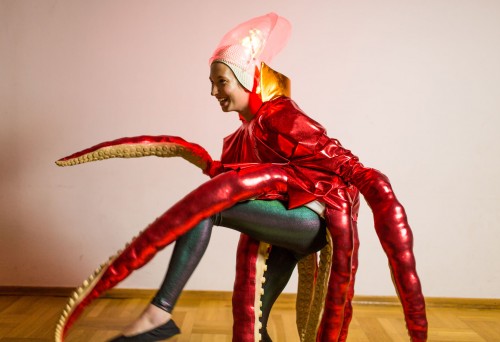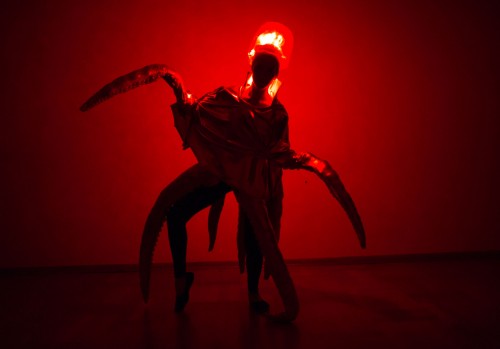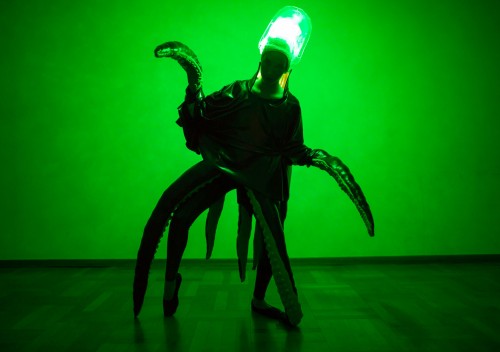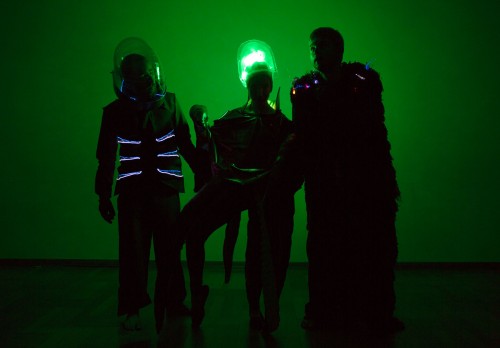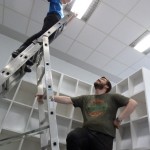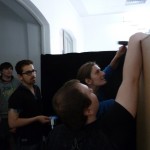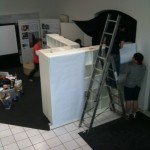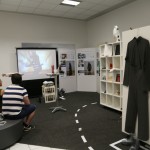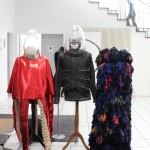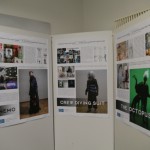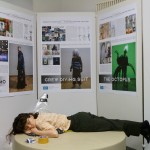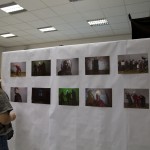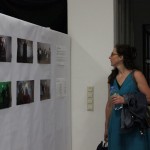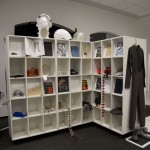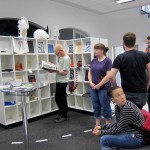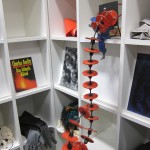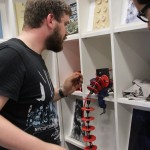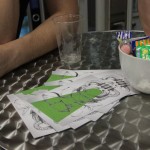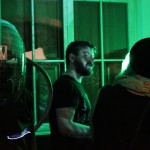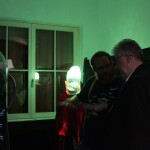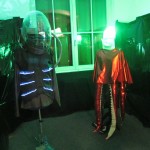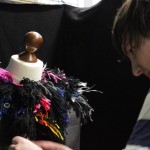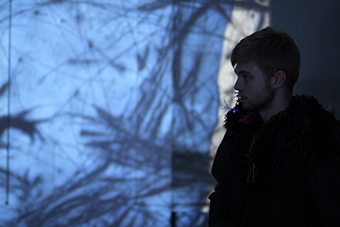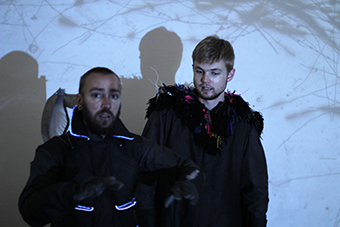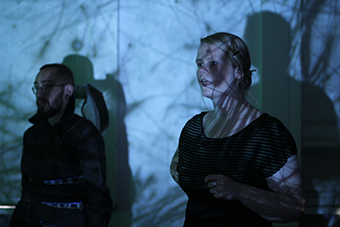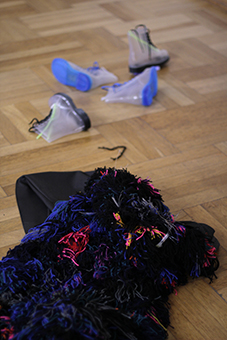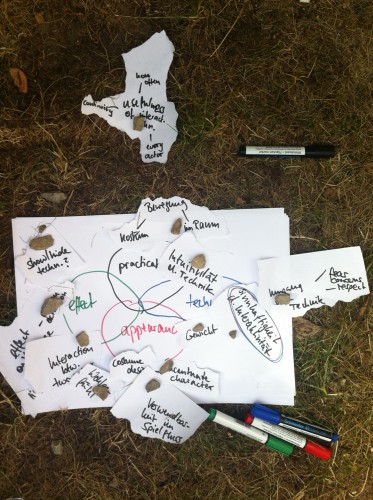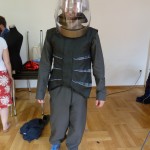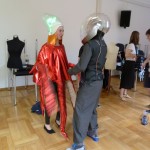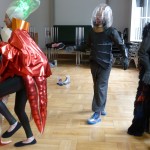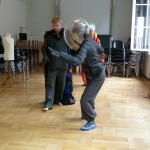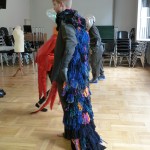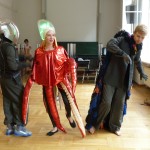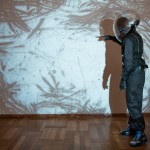Category Archives: Research
The NEMO costume re-tested.
On 15 August the Rafael Ecker came to HCI lab and Tested the costume once again.
Design Acting – Octopus
Final Exhibition – Summaery – Open Lab Night
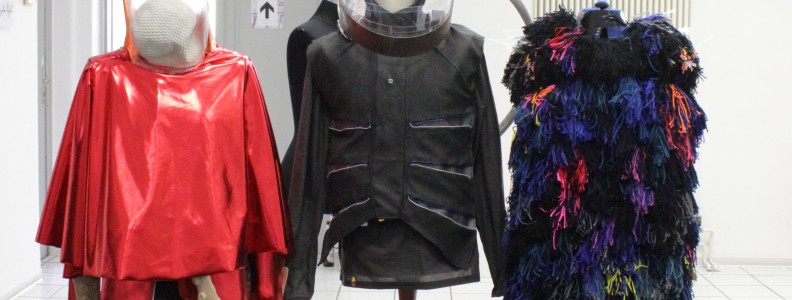
Dear All,
we present to you: our final exhibition!
The designers always come up with these crazy ideas that are a lot of effort. I guess in the end it was worth it. We presented the project – costumes, mock- ups, prototypes, pictures and movie in the entrance hall of Bauhausstraße 11. We tried to make it an overall experience so that the visitor understands the project´s goal. The visitor had to pass shelves filled with prototypes and inspirational material. The video that was shot during the design acting weekend gave a perfect introduction to our project´s idea and storyline.
We created a small dark nook to present the costumes with their interactive properties. The visitor really had to enter a “different” world – the Nautilus perhaps?
See here some impressions of set up and opening of our successful exhibition!
Design Acting Workshop
Design Acting – Final Workshop – Diver Costume´s First Time in Action
Our final Design Acting Workshop took place one week before the final grand university exhibition called Summaery!
It´s been an exhausting time, since the workshop meant to have the costumes ready to be worn by actual real actors. We only had two days to plan, try out and actually develop and shoot a short performance with all three costumes in action. Friday we spent the day planning the performance/ scene. It meant getting an overview on each character, their presumed “personality traits” and technical features that will enhance those characteristics.
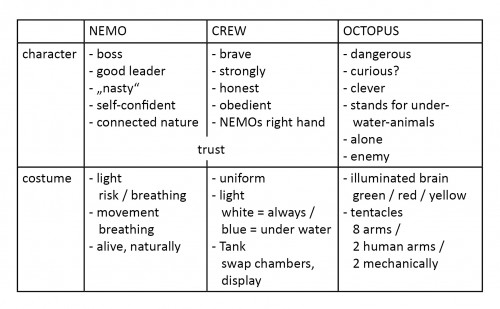
Next step was, to develop a short scene where all characters/ costumes would interact with one another — Where all technical and character traits would also become clear.
Scene we came up with:
Captain Nemo and his right- hand Crew Member exit the Nautilus for an exploratory mission to the bottom of the sea. While exploring they get too close to the dwelling space of the octopus. They bother him a little too much, so the octopus gets excited and finally angry when the Crew Member tries to attack it. The octopus is stronger and tries to drag the Crew Member aka Diver into his dwelling place. Finally Captain Nemo comes back to rescue his comrade.
We planned to film the entire day with the goal to observe the actors, how the costumes are fit for their character, etc. To get some facts, we developed a catalogue of questions in form of an interview. We have some film footage of interviewing the single actors. Plan is to evaluate and judge our work with the collected information.
We all were really stressed out and nervous on that important day when the actors came in. Really we thought it would be disastrous since none of our costumes was working quite right. We had a lot of technical problems to deal with. In the end though, it worked out fine! The actors fit into the costumes perfectly. Not just size wise, but also character wise. It was so good to see them “using” the costumes in that way.
Here are some impressions:
Methods and Tools, Playacting and Focus Troupes
Original: Methods and Tools Playacting and Focus Troupes: Theather techniques for creating quick, intense, immersive, and engaging focus group sessions. Authors: Steve Sato and Tony Salvador Keywords: acting, design, product developing, theater techniques, Summary: Live Theater can create strong shared contexts in which the focus is on interaction. Through the researches live theater and improvisation can quickly immerse and involve participants in designing new products. Main Contents:
The technics involve performing quick, intense and engaging activities. This activities focus on developing a shared context. They explore new product concept through using theater methods. Learn from how the participants and co-creater develop the new product and context for its use.
The workshops that they generated the collection of technics for new product development. Focus groups that are used to develop or evaluate new products and achieve some of achieve some of mockups. The result of the sessions contains comments and conversations about the product in context of the presentation.
Feasibility of the living canvas
Original: Naef, M. & Boyd, C. (2008). Feasibility of the Living Canvas – Restricting Projection to a Performer on Stage. Proceedings of the 16th ACM international conference on Multimedia, p. 589-598
Authors: Martin Naef, Cathie Boyd
Keywords: Projection systems, dynamic projection surface, virtual costumes
Summary: The idea for the living canvas is to capture the posture, silhouette and position of the actor and then use that as a projection along with a canvas as a stage background. For the reaction was divided into two area: the technical feasibility and the cooperation with stakeholders persons (such as actor, director). The developers of the living canvas presented as other future projects, so that they many new developed and evaluated.
Main Contents: In the paper the test environments and their results will be described in great detail. Here are just detailed information on stage and clothing, as they are for our interactive costumes most interesting.
Stage: It is so described that it consists of a regular projection screen and the actor is positioned in front of it. The technique for recording and projection will be installed in front of the stage. For the development was first worked on a small stage model with dolls as a performer on a table. Next, a laboratory environment has been created. This one had original size and could make calibrations.
Clothes: In this environment, they also tested various garments and fabrics, to see if they are suitable and how they look in the projected state. The clothes of the actor should preferably be diffuse pattern and no strong highlights to clearly reveal the silhouette, so you can well separate it from the background. The materials used should be matte white so that highlights are minimized. Different substances were illuminated, to see which is the best. Velvet was one of thefavorite. There are fewlimitations onthe design.
In order to develop the system, so that it can be used on a right theater stage, was the next step to test it with real actors. This was done in a week-long workshop in Glasgow. So the criteria of the developers could be tested under real conditions. There were mixed opinions of the people. At next followed more experiments, to get the system ready for a theater production.
Ideas for costume evaluation: The paper employ with costume, stage, lighting and much more, so that we can orient only on parts. In view of our evaluation, the idea is very good, only in scale and then to work in original size, so can errors discovered in small size. The many different tests and their approach (e.g. for the fabric) very interesting for us. Also the test in a workshop with the people who have to work with it later.
An Unfinished Drama: Designing Participation for the Theatrical Dance Performance Parcival XX-XI
Original:
Gesa Friederichs–Bu ̈ttner, Benjamin Walther–Franks, Rainer Malaka, (2012). An Unfinished Drama: Designing Participation for the Theatrical Dance Performance Parcival XX-XI “DIS 2012, June 11-15, 2012, Newcastle, UK.Copyright 2012 ACM 978-1-4503-1210-3/12/06…$10.00.”
Keywords:
Interaction; Theater; Digital Media; Dance.
ACM Classification Keywords:
J.5. Arts and Humanities: Miscellaneous
Summary:
The paper focuses on the use of digital media for plays in theatres and a set of requirements and four interactions are introduced to make audience interact in theatrical play actively with the use of gestural interfaces.
Main Contents:
By joining the disciplines of Art with technology, the plays can be showed more efficiently and meaningfully than before like the use of sounds, recorded videos, live projection to improve the scenery of the play and participation of audience in the act, all at the same time can blur the linearity of a play and bring new interaction challenges. The paper focuses on narrative performances of audience interactions with the play. After seven times play of “Parcival XX-XI” drama and 30 audience interviews of their interaction experiments, many of new challenges and interaction designs got introduced that the involvement of audience in the play is due to fun, frustration, fear and schadenfreude. At the same time four “interaction-enabling” principles that are required for audience’s in-play interaction, are introduced as audience interest in the play, interest in involvement of the play, performing interaction be valuable experience for him or her and last valuable experience be shared to all audience.
Parcival XX-XI is an artistic field research which audience, two media artists, one dramaturge, one choreographer, two light technicians, six dancers, other performers, have contributed and is performed seven times with many audiences ranging from 50 to 130. Play is done with very little stage design with video projection and Nintendo Wii-mote control used for interaction. The non-linear play has two scenarios in which audience are allowed to take part using the remote control to interact with virtual avatars on stage, mean time dancers also react according to audience actions, there is always “Wii fairy” to help audience for technical issues. If the Parcival XX-XI cannot show the dramatic composition image then it is failed and piece is remained un-finished, but luckily until now no play is remained un-finished.
The scenarios are unsolvable problems, like four audience stand in front of four other naked dancers and they are asked to dress or undress them only with three digital projected dresses by using two gestures (steal, hold) dancers wear, so as a result one of the dancer always remain naked. This is to let the audience to realize that there is no actual solution, therefor; individual solutions are required for problem solving and face the effect of their action on dancers and play.
Thirty audiences aged between 24 and 63 from which 20 men and 10 women were interviewed and each interview took 5 to 20 minutes and three main questions were asked. “Which aspects especially caught your eye? How did you perceive the use of digital media? How would you rate the usage of Wii-mote controllers?”.
Findings:
A: Audience agreement or rejection of participation is due to Fear, fun, frustration schadenfreude.
B:The audience often experienced the participation as disruption of the play because
1: Written language was used in participatory scenario.
2: The scenarios occur at an inappropriate point of time of play.
3: Only two gestures for participators.
4: The scenarios required a shift from passive spectator to an active role on stage.
Based on the results four interaction-enabling criteria are introduced for theatrical plays, and these criteria are also applicable for theatrical performance that require interaction and employ gestural interaction. The criteria are to prevent the drama from an unfinished state.
1: The audience should be interested to get involved with the work.
2: An interested audience should be able to do the interaction.
3: Performing the interaction should be a valuable experience for the interacting person. :
4: The valuable experience should not only be reserved for the person interacting with it, but should be shared with everyone else around.
Getting one person involved in an interactive task is not an easy work, first because in many occasions the person may feel baffled, ashamed, insecure, unfamiliar and even afraid of technologies used.. Parcival XX-XI is introduced as a participatory play to the audience, so that they expect more and volunteer themselves to contribute in. second embarrassing situation for participants should be avoid by asking many participants at one time to come on the stage, third the play should make the audience realize that play is interactive and desirable, by projecting a text on stage or playing a sound, in this play Wii Fairy supported audience with the play.
Ability is the second requirement where the audience should be able to use the tools, since every person varies in age, profession and other characteristics, Nintendo Wiimote was chosen because that could transfer relevant message, the device were thought to audience before the play.
Participants should achieve valuable experience, they must see the reaction quick and correctly but due to some technical problems of Nentendo Wiimote and projection delay, this was somehow not understandable for them.
The play should not only be valuable experience for participants but also for viewers, any interaction made on stage play must have dramaturgical impact on the drama, therefor pre-performance was designed to ensure that participants understand the usage of controllers and effects they can make on a play.
Ideas for costume evaluation: ?
We should keep in mind about the technologies being used inside the costume that the performer should not feel fear, shy or embarrassed and at the same time it should respond to the perfumers expectation.
Experience Design Theatre: Exploring the Role of Live Theatre in Scaffolding Design Dialogues
Original: Vines, J., Denman-Cleaver, T., Dunphy, P., Wright, P. & Olivier, P. (2014). Experience Design Theatre: Exploring the Role of Live Theatre in Scaffolding Design Dialogues. CHI ’14 Proceedings of the SIGCHI Conference on Human Factors in Computing Systems. Pages 683-692.
Authors: John Vines, Tess Denman-Cleaver, Paul Dunphy, Peter Wright & Patrick Olivier
Keywords: Scaffolding, experience-centered design, theatre, care, older people, intergenerational
Summary: Experience Design Theatre with several diverse groups of people, different age, in the early beginnings of a design using experience-centered designs. In EDT small groups of participants are formed, which engage in a theater piece about the design of product, and then to share their concerns and aspirations with domain experts. Theatre gaining more and more importance in HCI.
Main Contents: For the development of a design different age groups are formed. Then the product, through experience-centered-design, role-play and non-scripted-live-theatre, evaluate. By the live theatre and improvisation, scenes can be changed individually, by sudden dynamics of the group to integrate the experiences of the people in a unfinished piece.
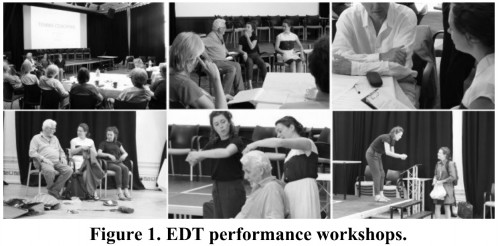
From the original paper: Experience Design Theatre: Exploring the Role of Live Theatre in Scaffolding Design Dialogues
In the Experience Design Theatre process all workshops and performances will be recorded to experience to conclude. It is improvised, with few rules and after the piece a new piece is then shaped it. There are 5 phases:
- Phase 1: Definition of situations and starting scenes
The responsible of the theatre will be trained how the design should look like and must be paid to what, then the people are selected according to various criteria. - Phase 2: Rehearsal workshops
The purpose of the five workshops was to show some scenes and ask participants do help us redirect them to convey their own experiences of care. - Phase 3: Performance development
Extracts of re-directed scenes and any missed details of contrasting view where reworked into a number of more developed episodes. - Phase 4: Voice Validation Workshop
At the end of the performance participants were invited to voice their views on the performance. - Phase 5: Public Voice Workshop
This is a public performance. The primary aim of this performance was to communicate to the domain-experts what the user experience of the design might be like. And generate discussion about the design implications.
“Live theatre provides a responsive space for sharing experiences between participants, designers and research teams and iteratively prototyping future experiences.”
Ideas for costume evaluation: The paper does not contain a lot of useful information that we can use in the final phase of the costume. In this excerpt, it was a matter that older people work with younger and reviews this design. In our project, it would be the actor and our group.

